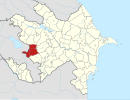Qamışlı
Qamışlı | |
|---|---|
 | |
| Coordinates: 40°12′23″N 46°11′41″E / 40.20639°N 46.19472°E | |
| Country | |
| District | Kalbajar |
| Population (2015)[1] | |
| • Total | 249 |
| Time zone | UTC+4 (AZT) |
Qamışlı (Azerbaijani pronunciation: [gɑmɯʃˈlɯ]) is a village in the Kalbajar District of Azerbaijan. It is situated along the Levçay river.
History
[edit]Qamışlı was part of the Jevanshir Uyezd of Elisabethpol Governorate during the Russian Empire. According to 1886 census data, there were 22 homes and 183 Kurds of the Shiite branch of Islam in Qamışlı.[2] According to the 1912 publication of the Caucasian Calendar, the village of Qamışlı was home to 121 people, the majority of whom were Azerbaijanis (classified as "Tatars" in the census).[3]
Qamışlı was part of the village council of the same name in the Kalbajar District of the Azerbaijan SSR during the early Soviet period in 1933. The village had 58 farms and a total population of 320 people. The population of the village council, which also included the villages of Ağdaban, Bağırsaq, Bağırlı, Yanşaq, Susuzluq, and Zallar, was 100 percent Azerbaijani.[4]
During the First Nagorno-Karabakh War, Qamışlı changed hands several times. The Armenian forces launched an offensive in 1993, capturing the entire Kalbajar district. A year later, during the Operation Kalbajar, Azerbaijani forces recaptured Qamışlı, but the Armenians soon launched a counter-offensive, forcing the Azerbaijanis to abandon the village.[5] It was later incorporated into the breakaway Republic of Artsakh as part of its Shahumyan Province, where it was known as Yeghegnut (Armenian: Եղեգնուտ). Qamışlı was returned to Azerbaijan on 25 November 2020 as part of the 2020 Nagorno-Karabakh ceasefire agreement.
Historical heritage sites
[edit]Historical heritage sites in and around the village include the medieval bridge of Shahi (Շահի, lit. 'of the king'),[6] a khachkar and a stele from between the 12th and 13th centuries,[1] as well as a 13th/14th-century chapel.[7]
Demographics
[edit]| Year | Population | Ethnic composition | Source | ||||||||
|---|---|---|---|---|---|---|---|---|---|---|---|
| 1886 | 183 | 100% Shiite Kurds | Transcaucasian Statistical Committee[2] | ||||||||
| 1912 | 121 | Mainly Tatars (later known as Azerbaijanis) | Caucasian Calendar[3] | ||||||||
| 1933 | 320 | 100% Azerbaijanis | Statistics of Azerbaijan SSR[4] | ||||||||
| 1993: Occupation of Qamışlı. Expulsion of Azerbaijani population | |||||||||||
| 2005 | 171 | ~100% Armenians | NKR census[8] | ||||||||
| 2015 | 249 | ~100% Armenians | NKR estimate[1] | ||||||||
Gallery
[edit]-
13th/14th-century chapel
-
13th/14th-century chapel
References
[edit]- ^ a b c Hakob Ghahramanyan. "Directory of socio-economic characteristics of NKR administrative-territorial units (2015)".
- ^ a b Свод статистических данных о населении Закавказскаго края, извлеченных из посемейных списков 1886 г. Tiflis: Transcaucasian Statistical Committee. 1893. p. 243.
- ^ a b Кавказский календарь на 1912 год [Caucasian calendar for 1912] (in Russian) (67th ed.). Tiflis: Tipografiya kantselyarii Ye.I.V. na Kavkaze, kazenny dom. 1912. p. 162. Archived from the original on 11 December 2021.
- ^ a b Административное деление АССР [Administrative divisions of the ASSR] (in Russian). AzUNKHU. 1933. p. 42.
- ^ Velimamedov, Mamed (2021). Карабахская война 1991-1994 [Karabakh war 1991-1994] (in Russian). Moscow: Editus. pp. 56–61. ISBN 978-5-00149-643-4.
- ^ Samvel Karapetyan (2001). Armenian Cultural Monuments In The Region Of Karabakh (PDF). Research on Armenian Architecture.
- ^ "The Chapel of Yeghegnut". Monument Watch.
- ^ "The Results of the 2005 Census of the Nagorno-Karabakh Republic" (PDF). National Statistic Service of the Republic of Artsakh.










